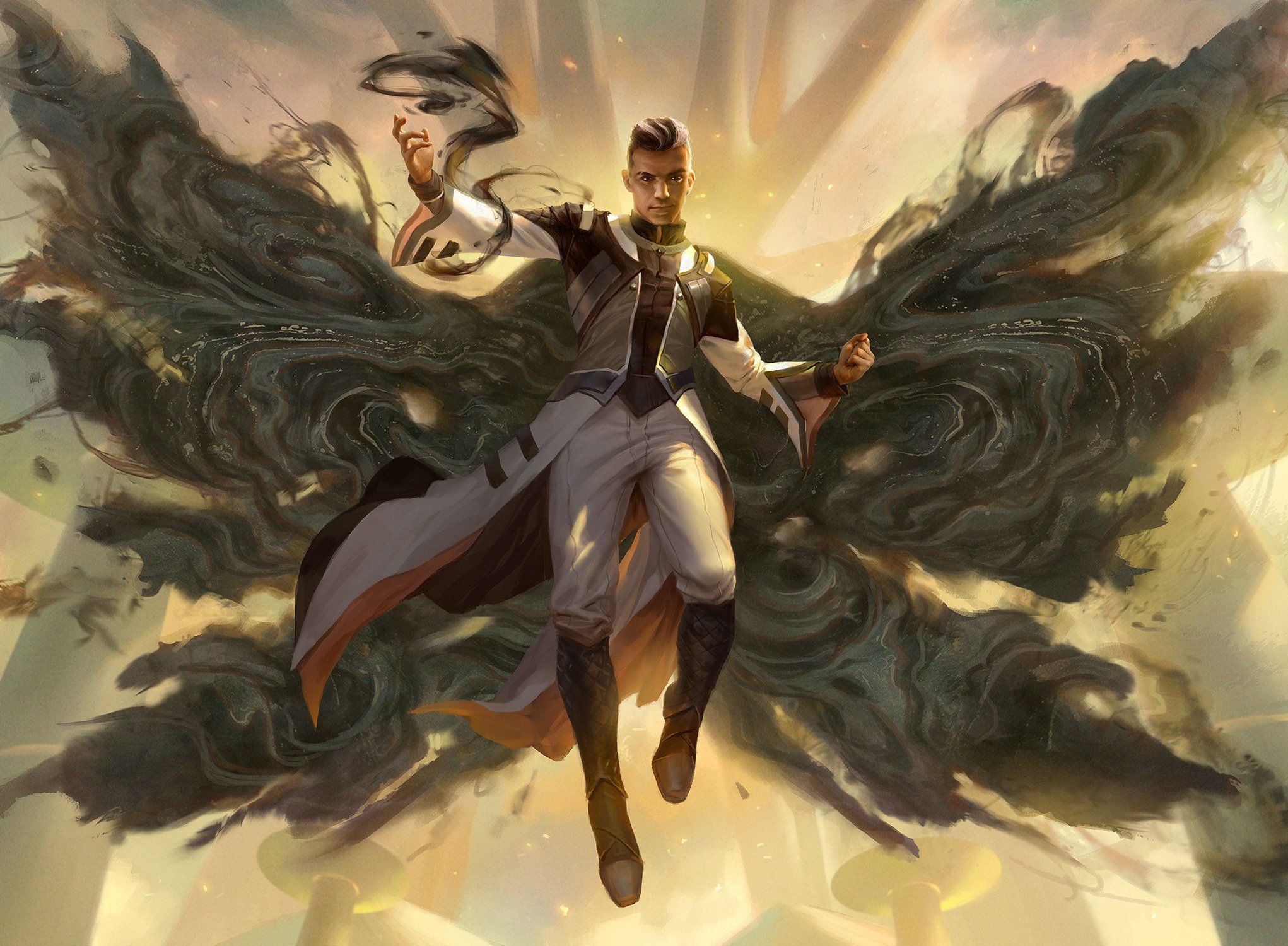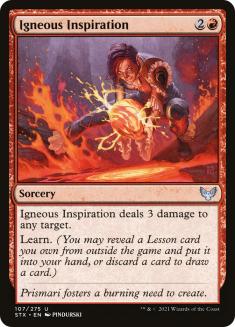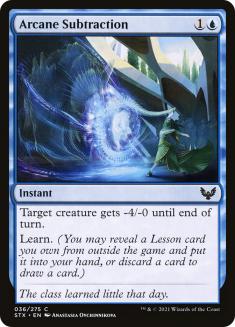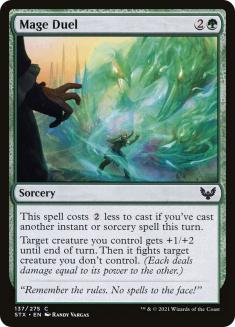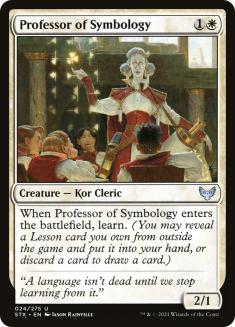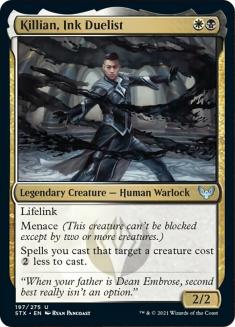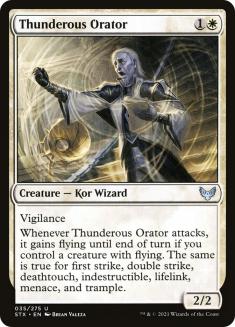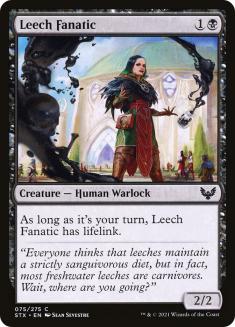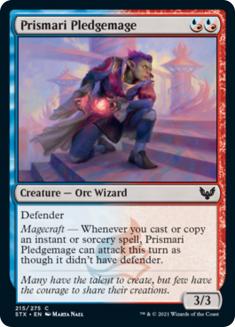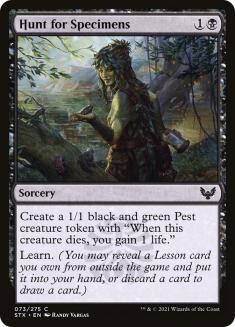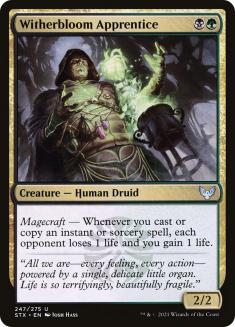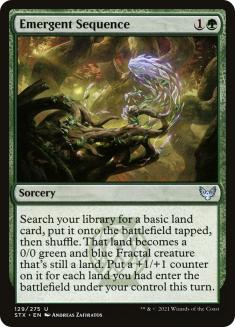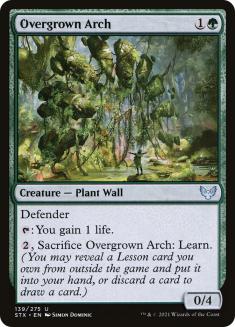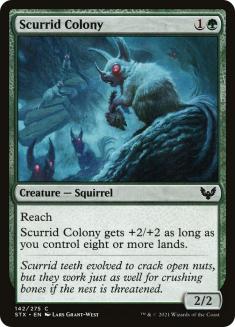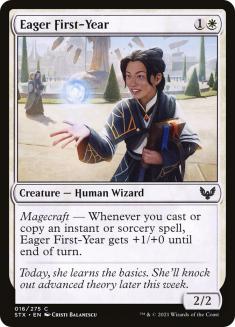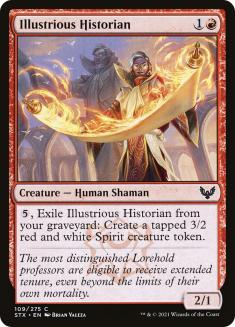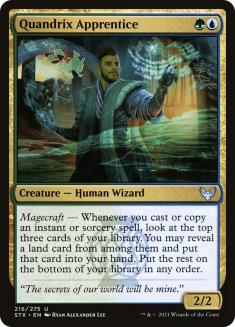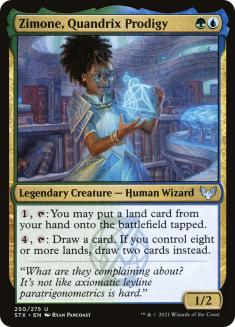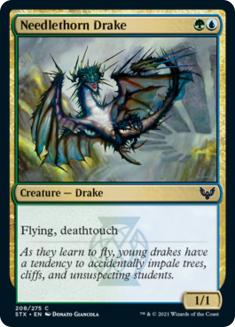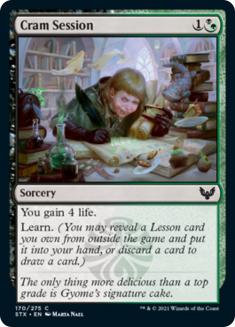Strixhaven offers a relatively slow Draft format in which most games last a long time and players rarely run out of things to spend mana on. Even if a player somehow casts all of their spells, despite the fact that cards that learn add more spells to their hand, they still usually have a Campus to spend mana on that will help them find more spells. While it would seem reasonable to think that casting a creature on Turn 2 isn’t that important if the game is going to last a long time regardless, the more I’ve played Strixhaven, the more I’ve prioritized casting a creature on Turn 2.
Learning and Lessons play somewhat similarly to Adventures, except you can mix and match which two cards are attached to each other, rather than having Stomp always find Bonecrusher Giant. The spells are also a little further below standard rate than they were on Adventure creatures (because that mechanic was particularly pushed), but in Limited, they’re still very strong.
When your learn spell finds a Lesson that costs an amount of mana of your choosing, it’s very easy to sculpt your game to spend most of your mana. You can draft an aggro deck with a curve that stops at three, but if you have a lot of learn cards, you’ll finish most games before casting all your spells. Since most games are won by the player who spends more mana, and both players never stop spending mana, the player who spends more mana will be the player who starts spending mana earlier.
More importantly, cards with small effects that interact with creatures show up a lot more because they learn. Arcane Subtraction, Academic Dispute, and Guided Voice are important cards to cast early that are much stronger if you reliably have an early battlefield presence. It’s very easy to kill a creature and learn with Arcane Subtraction or Academic Dispute if you can use either to create a favorable combat that wouldn’t have happened or wouldn’t have been favorable otherwise, but you need a creature on the battlefield to have such an opportunity.
Strixhaven also has strong fight spells in Mage Duel and Devouring Tendrils, but you can only reliably use these if you have enough creatures. These cards make it particularly important for green decks to prioritize cheap creatures to make sure they always have something on the battlefield that can fight.
Additionally, removal in Strixhaven is particularly good and there are a lot of common removal spells that don’t care how big a creature is, which means the more you invest in a creature, the more likely you are to end up down on mana when it trades with a removal spell.
Early on, I drafted a lot of Prismari decks that I wanted to fill with instants and sorceries, and these decks usually played from behind, spending their first turns manipulating cards with Curate or casting Arcane Subtraction just to learn, and then tried to catch up with removal and big creatures. If you get enough premium removal spells, this might work, but I typically lost to white creature decks that curved out.
These days, I’ve been winning a lot more and my top priority is not falling behind. I really like to know if I’m an aggro deck or a control deck, and to draft with a certain role or gameplan in mind, but I’ve found these blurring lately, as my focus on battlefield presence in control decks often leaves me in a position to pressure my opponent and I accidentally end the game quickly. This means I’ve drifted toward drafting more midrange decks, which is honestly a pretty good development I think, as I think I tend to push too strongly toward decks that have a certain plan, when it isn’t really necessary.
So how exactly should you prioritize two-drops when drafting? That depends on your colors.
Silverquill
Professor of Symbology and Killian, Ink Duelist are among the best cards you can draft, and you should take either of them over any common or uncommon at basically any point in a draft.
Thunderous Orator is the next-best two-drop, and should be taken over every common except sometimes Combat Professor, but generally behind premium uncommon removal like Closing Statement and Flunk.
Hunt for Specimens is the next-best two-drop. It’s not ideal to cast on Turn 2, so it only somewhat counts, but using it to find Inkling Summoning to cast on Turn 3 gives you a very reliable functional start that plays really well with removal-heavy draws.
Leech Fanatic is generally a little better than Silverquill Apprentice, which is a little better than Arrogant Poet and Eager First-Year. All of these have negative impacts on your win rate according to 17Lands.com’s stats, but that doesn’t mean you should strictly avoid playing them. Decks with premium two-drops will perform better, which is why those are such high priorities, but these are all better than not casting something on Turn 2.
This lower tier of two-drops shouldn’t be taken as a super-high priority — for the most part, you can take Lessons, cards that learn, and removal over them — but I’d try to have five to seven two-drops by the end of the draft, and I’d make any of these a priority if it didn’t look like I’d hit that number.
Prismari
Prismari Apprentice and Prismari Pledgemage are both fantastic. I’ve undervalued them due to a desire to keep my spell count high for Serpentine Curve, but passing these is going too far. They’re not as important as Heated Debate or Bury in Books, but they should both be taken ahead of every other common.
I think it’s acceptable to play only two to four two-mana creatures in Prismari, and to round your deck out with Curate and Strategic Planning, which leads to a curve that’s reminiscent of Izzet Giants in Kaldheim. You really want to prioritize Prismari Pledgemage though, because you want at least two two-drops, and your next-best options, Illustrious Historian and Burrog Befuddler, are a huge step down.
Witherbloom
Hunt for Specimens is actually the highest-performing two-drop in Witherbloom, which is kind of amazing, but these decks are often looking to start with a battlefield full of Pests by opening Hunt for Specimens into Pest Summoning, and this archetype doesn’t make use of Scurrid Colony as well as Quandrix or Leech Fanatic as well as Silverquill.
Witherbloom Apprentice is the next-best two-drop in Witherbloom. Its trigger is nowhere near as flashy as Quandrix Apprentice, but it does good work.
Emergent Sequence and Overgrown Arch are the other uncommons you really want. Note that none of these two-drops are particularly good at attacking; all of them are just trying to set up the rest of your game. Witherbloom isn’t about aggressive creatures, it’s about gumming up the battlefield and going over the top with big creatures and removal spells.
Incidentally, this is why Blood Researcher isn’t a very good card. In addition to requiring a lot of investment that can all be undone fairly easily, it’s not really on-plan for Witherbloom unless it becomes your plan, but it’s not good enough to justify that.
Scurrid Colony is way ahead of the rest of the commons. Reach is critical, as it always is for green and black decks. Leech Fanatic, Reckless Amplimancer, and Dina, Soul Steeper are acceptable filler, but considerably worse than the other options.
The primary takeaway here is that you should prioritize Hunt for Specimens extremely highly, as it’s important to do something on Turn 2, but most common options aren’t great for your plan.
Lorehold
Professor of Symbology is peerless here, and you’d still love to find Thunderous Orator.
For the most part, you’ll have to rely on commons, where Eager First-Year followed by Illustrious Historian are your best bets. The three-drops are more interchangeable, so you should prioritize these premium two-drops over three-mana common creatures, except Pilgrim of the Ages if you’re playing a more controlling Lorehold deck.
Stonerise Spirit and Blood Age General are your failsafes if you can’t find the premium common two-drops, and they generally won’t need to be prioritized.
Quandrix
Emergent Sequence is the best two-drop in Quandrix, since it ramps and fixes your mana in addition to giving you a battlefield presence.
Quandrix Apprentice is the next-best option, but it may not be as clear as it is with Silverquill that that makes it the highest priority to draft. Quandrix has an abundance of great two-drops and a shortage of premium interactive spells, which means that you might prioritize Bury in Books or Mage Duel, especially at the beginning of a draft, when you might prefer to take a more flexible, monocolor card over a gold card. If you know that you’re Quandrix, it depends on how many two-drops and how many interactive spells you have, and I think Quandrix Apprentice is close to these in power level. If I know I’m Quandrix, I generally prefer the Apprentice though.
Zimone, Quandrix Prodigy is a little behind Quandrix Apprentice, but ahead of the rest, though not by as much as you might think.
Scurrid Colony, Overgrown Arch, and Needlethron Drake in that order are the rest of the premium two-drops for Quandrix, and I like all of them more than every three-mana common or uncommon creature, but if you have a lot of two-mana creatures already, you might take Frost Trickster or Quandrix Pledgemage over them.
Reckless Amplimancer is a step down, but I’m happy enough to play it, while Burrog Befuddler and Soothsayer Adept would be an indication that something went wrong and I’m desperate for two-drops.
I think it’s fairly obvious that aggressive white decks want to prioritize two-drops, but it took me a bit of experience to realize how critical they are for Quandrix regardless of the plan for the rest of the deck. Maybe you’re planning to tempo your opponent out with Frost Trickster, fight spells, and counter spells, or maybe you’re planning to ramp with Field Trip and Eureka Moment and win the game with big Fractals. Either way, a successful Quandrix deck starts with a good curve and strong two-drops.
Seeing that plan out in Quandrix taught me how important the two-drops are in Prismari and Witherbloom, but it’s harder in those archetypes because there are few good options. Both of those colors need to supplement by prioritizing removal very highly. It can be a little hard for Prismari to find cheap enough removal, since Shock is uncommon and the best available at common is Heated Debate, but Witherbloom can lean on Lash of Malice and supplement with uncommons like Flunk and Eliminate.
Cram Session isn’t really a two-drop, but if Witherbloom starts with Cram Session into Pest Summoning, they’re not too likely to lose to an aggressive deck before they can play larger creatures. The sparsity of the reach keyword can make it hard for them against flyers if they don’t have Lash of Malice or Scurrid Colony.
One big difference between Strixhaven and Kaldheim is the quality of one-drops. Jaspera Sentinel, Battlefield Raptor, and Ferocious Pup were all strong commons that usually found their way into someone’s deck, while Star Pupil and Unwilling Ingredient are both fringe playables — if they make it into someone’s deck, they’re much less likely to matter in a game. This is largely because of the strength of the Equipment in Kaldheim. This put the full weight of the early-game on casting a two-drop specifically, but also means that you’re less likely to be facing multiple creatures by the time you can cast a three-mana removal spell.
Eyetwitch is notable as a one-drop that’s actually good, and while I didn’t include it in these lists, it should be prioritized in black decks. Unwilling Ingredient shouldn’t be prioritized the same way, but it’s a serviceable way to round out an early-game to make sure you don’t get run over in Witherbloom, or another evasive threat in Silverquill.
Lesson Learned
There are a lot of cool, flashy spells in Strixhaven, but don’t forget the fundamentals. If you start with a two-drop, it’ll buy you a lot of time for cards like Field Trip, Pop Quiz, and Eureka Moment. Strixhaven might be about instants and sorceries, but Limited Magic is still about creatures.

